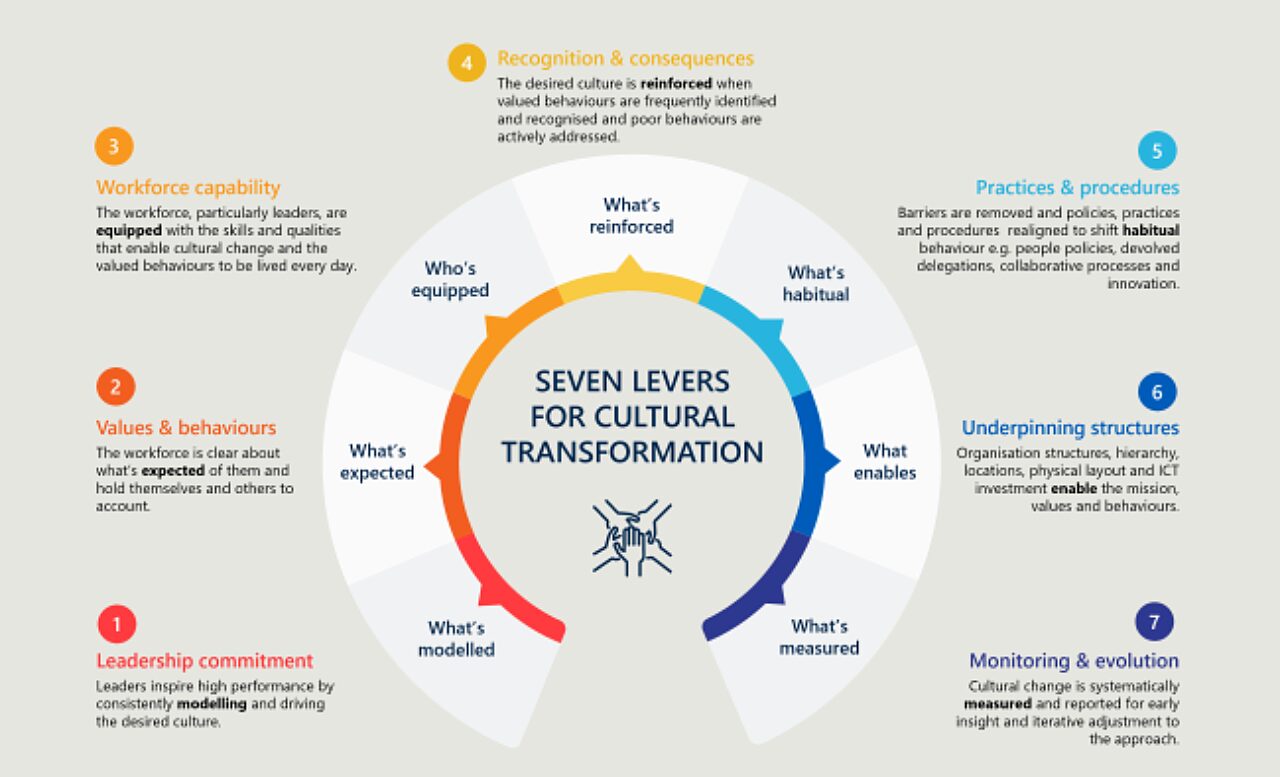Idea In Brief
Strategic investment
Intentional and strategic investment in culture is needed to ensure it is aligned to strategy and purpose. Without investing in culture, efforts to improve an organisation’s performance are likely to fail.
Starting point
Knowing your starting point for investing in culture is critical. Your starting point will indicate the scale of effort, appropriate level of investment, and approach to culture change you need.
Three elements
From our experience working with large companies, government agencies, universities and not-for-profit organisations, there are three key elements that successful culture change programs have in common.
The importance of culture to an organisation is widely recognised – and with good reason. There is a mountain of evidence that culture plays a fundamental role in organisational performance.
When we talk about culture, we are referring to collective mindsets (how we think) and collective behaviours (how we act).
We know that intentional and strategic investment in culture is needed to ensure it is aligned to strategy and purpose. Without investing in culture, efforts to improve an organisation’s performance – whether that is through implementing a strategy or changing structures, systems or processes – are likely to fail.
Despite this, we continue to see underinvestment in culture across many organisations. The complex and intangible nature of culture can often be a barrier, as can the requirement for long-term and sustained effort. Culture can be hard to shift, and so often is left untouched.
So how can organisations take practical action to shift culture?
In this article, we draw on our experience working with leaders across industries to identify the elements of successful culture change.
Drivers for culture change should determine the approach and investment
Knowing your starting point for investing in culture – and the underlying drivers for change – is critical. Are there signals that you are not achieving your full potential? Are you falling behind your competitors? Are you seeking to take a more deliberate approach to evolving your culture? Or is your organisation experiencing a culture crisis?
Your starting point will indicate the scale of effort, appropriate level of investment, and approach to culture change you need. For some organisations this could be a full-scale culture transformation, for others, a more evolutionary approach to change is appropriate.
This information will also equip your organisation to overcome the challenges and barriers to investment.
Our experience points to three elements of successful culture change
There are many organisational levers that influence culture, which are reflected in Nous’ Seven Levers for Cultural Transformation model.


It is true that organisations seeking to transform or evolve their culture will need to pull many, if not all, of these levers to create sustained change. But from our experience working with large companies, government agencies, universities and not-for-profit organisations, there are three key elements that successful culture change programs have in common.
These require low investment and have large impact, irrespective of your starting point. By focusing on these three elements, we have supported organisations to move from a state of culture inertia towards sustainable culture change.
Put your people at the centre of your organisational and culture change strategy. People are central to an organisation’s success; recognition of this, among senior leaders especially, is a key foundation for culture change. Nous has supported many organisations to move from giving ‘people and culture’ peripheral consideration, to viewing these as strategic imperatives and positioning them as such through strategy documents and plans.
People are also central to a successful culture change journey. Leaders need to listen to their people in order to understand how their culture is experienced and the potential barriers and motivators for change. Surveys, virtual or face-to-face listening sessions, or a dedicated email channel to the CEO are practical examples that organisations can use to provide a voice to their people to inform their culture story.
Mobilising your people to create a movement will help your organisation to shift its culture. While we know leaders need to role-model expected behaviours and set the tone, culture is most effectively shaped when it is the collective responsibility of all employees. This requires organisations to harness excitement and commitment in each person in each role so they become accountable for how they influence organisational culture.
Set a clear narrative for where you want to go, and how you plan to get there. As with any organisational change, a clear vision and compelling narrative to set direction and engage people is key. Assessing your current culture is helpful in identifying pain points, then it is vital to have a clear and shared vision for your aspirational culture. This allows you to create consistency among leaders, build shared understanding, communicate the need for change that speaks to all your people, and set expectations clearly.
With your aspirational culture clearly defined, you can develop a roadmap that outlines what change is needed to get there, what you will focus on, and how you will measure success. It is important to break down the activities that will shape your culture, to bring your culture story to life via SMART goals (those that are specific, measurable, assignable, realistic and timebound), and to ensure someone is accountable for each activity.
Make culture change tangible by anchoring in routines. Overcome the elusive nature of culture by keeping activity related to managing culture practical and visible. Keep an eye on the formal behaviours that are reinforced and the informal ways of working that bring culture to life. This helps an organisation’s people to understand what is expected of them and each other, and how to put this into practice.
Expected behaviours need to be reinforced by routines and rituals – the ways behaviours are embedded in an organisation. This also calls for leaders, and culture champions at all levels, to role model the culture through their action. Culture change is driven by actions, not words.
An example of the power of routines is the Acknowledgement of Country that now forms the start of formal gatherings in Australia, cultivating and reinforcing a culture of reconciliation across organisations and communities. Nous has supported organisations from global mining companies to government human services departments to create and embed routines that have supported culture change, from toolbox meetings to kanban boards.
This approach can deliver strong results
It is true that culture change is complex. Focusing on these three key elements of successful culture change can help organisations move from inaction towards achieving their desired culture.
We have seen organisations use this approach and achieve strong results. They are experiencing improved performance, higher customer satisfaction, reduced staff turnover and higher employee engagement.
Get in touch to explore how we can support your culture change efforts.
Connect with Anita Sarris and Kathy Voukelatos on LinkedIn.
Prepared with input from Iris Rattley and Rosalyn Reed.


